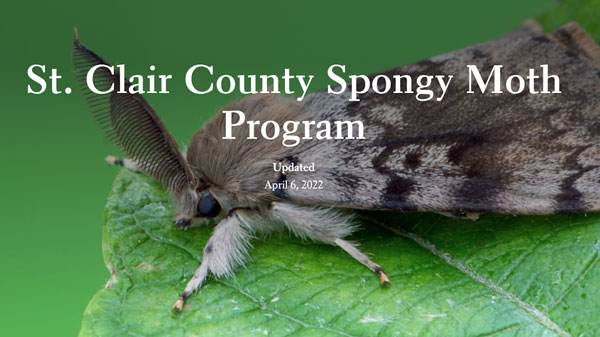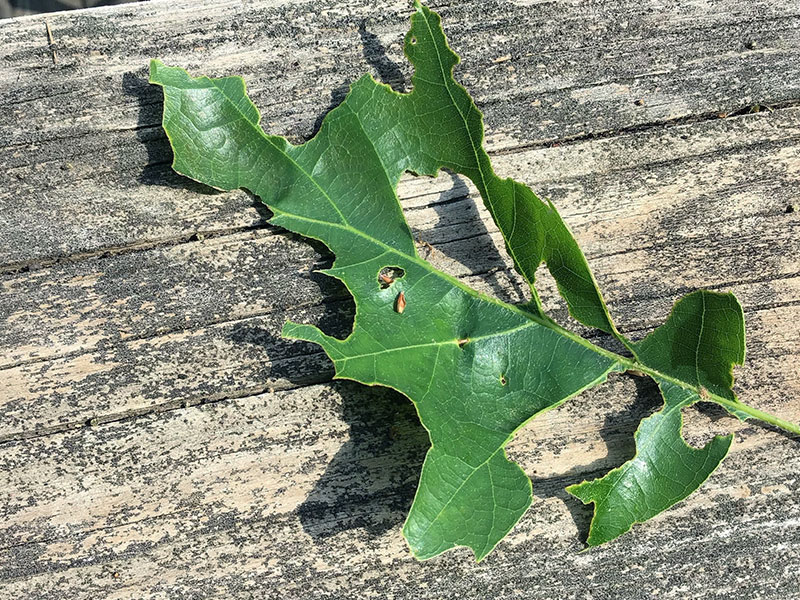
St. Clair County Spongy Moth Program
Protecting our natural resources and quality of life, together.


A female gypsy moth laying eggs
About the 2021 St. Clair County Spongy Moth Outbreak
In August 2021, Friends of the St. Clair River was contracted by St. Clair County to launch a Spongy Moth Program across the county. The need for this program was realized after local elected officials and county commissioners heard from hundreds of distressed and frustrated property owners who battled Spongy Moth caterpillars all spring and summer.
We are developing and leading this cooperative, collaborative Spongy Moth Program that remains cost effective, science-based, and protective of quality of life and natural resources. Our work utilizes a landscape-level strategy to engage multiple stakeholders while managing and stewarding the county’s natural resources.
Our expertise in land stewardship, environmental monitoring and educational programming allows us to advance and advocate on behalf of quality of life initiatives for St. Clair County.
St. Clair County Spongy Moth Suppression Program Goals:
- Reduce the nuisance of high caterpillar populations in forested residential areas
- Monitor and track outbreaks or infestations in St. Clair County
- Reduce tree stress
- Reduce the indiscriminate use of chemical controls
- Provide educational information
- Protect and improve quality of life and outdoor recreation activities
About the 2022 St. Clair County Aerial Suppression Treatment Program
St. Clair County contracted with Friends of the St. Clair River in January 2022 to manage the Spongy Moth Suppression Program. The suppression program’s main goal is to contract with a licensed certified pesticide applicator to assist residents with the aerial treatment of Btk (Bacillus thuringiensis var. kurstaki), a biological control, to qualifying areas in an effort to reduce intolerably high populations of spongy moth caterpillars. The estimated time of spraying is May to early June.
Exact application dates will be determined by weather and caterpillar development as spring progresses. Participation in the St. Clair County Spongy Moth Suppression Program is voluntary. St. Clair County is paying for 100% of the costs in 2022 associated with this spray treatment. For more information, visit www.stclaircounty.org/caterpillars.


The Spongy Moth Life Cycle: Know Before You Act
To avoid harming Michigan native species, please confirm what you are seeing is spongy moth, also known as Lymantria dispar, an invasive species, before taking action to manage it. The spongy moth images above will help you identify spongy moth at various stages of its life cycle. Avoid damaging tree bark, which can leave the trees vulnerable to other pests and disease, and wear gloves and safety glasses when you handle any part of the spongy moth at any stage of its life cycle to avoid its irritating hairs.
Spongy Moth pupae - present in summer – Female (Top), Male (Bottom)
Adult moths - present in summer - (Left: Male, Right: Female)
Spongy Moth egg masses with a half dollar coin; - present for 8-9 months in late summer through the following spring
Spongy Moth caterpillars on hiding band; - present in late spring and summer
Strategies for Landowners to Manage Spongy Moth
A combination of methods can and should be employed to combat the increase and spread of infestation. To avoid harming Michigan native species, please confirm what you are seeing is the invasive spongy moth, and not native species like Eastern tent caterpillars and fall webworms. Avoid damaging tree bark, which can leave the trees vulnerable to other pests and disease.

January-April:
Scrape & destroy egg masses
Remove and destroy egg masses prior to hatch. Every egg mass you destroy prevents 100 to 1,000 caterpillars from hatching. Wear gloves and safety glasses to protect yourself from the irritating hairs in egg masses.
- Search for spongy moth egg masses on trees, firewood, outdoor furniture, siding, and other outdoor surfaces
- Scrape egg masses into a container of soapy water and let sit overnight, or burn or bury the egg masses
- Any eggs that fall to the ground or get left behind can still hatch

April-July:
Sticky or hiding bands
Assemble your sticky or hiding band materials in late spring before caterpillars hatch in late April or early May. Wear gloves and safety glasses to protect yourself from the irritating hairs on caterpillars.
- Wrap trees with sticky or hiding barrier bands to trap caterpillars as they move up and down the trunks
- Follow precautions in the article to protect your trees from damage from sticky bands – Read Article
- Wrap trees with folded burlap barrier bands to trap the caterpillars – Watch Video
- Drop any collected caterpillars into a bucket of soapy water and let sit for 48 hours
- Spray caterpillars and moths directly with a strong mixture of dish soap and water. (Caution: can make surfaces slippery.)

May-August:
Report online, manage caterpillars
Report your spongy moth caterpillar issues and manage spongy moth caterpillar, pupa, and moth populations. Wear gloves and safety glasses to protect yourself from the irritating hairs on caterpillars, pupae, moths, and egg masses.
- St. Clair County residents should report spongy moth caterpillars online
- The Spongy Moth Suppression Program tracks and monitors residents reports to plan fall field work and gauge infestation levels
- Help trees defoliated by spongy moth caterpillars by watering, fertilizing, and avoiding damage to the trunks or roots
- Continue using sticky or hiding bands until caterpillars pupate and become adult moths
- Drop any collected caterpillars into a bucket of soapy water and let sit for 48 hours
- Spray caterpillars and moths directly with a strong mixture of dish soap and water. (Caution: can make surfaces slippery.)

July-September:
Slow the spread, make observations
Watch where spongy moth females lay their egg masses, but leave them in place until winter.
- Tree trunks, loose flaps of bark, house siding, bird nest boxes, and other outdoor objects are common places for spongy moths to lay egg masses
- Firewood, patio furniture, campers, and other portable outdoor objects are often methods of spread when egg masses hidden on these items are transported to a new location
- Don't move firewood from one place to another and check any outdoor items carefully and remove and destroy any egg masses before transporting items. All other egg masses should be left in place until winter
- Continue to help trees defoliated by spongy moth caterpillars by watering, fertilizing, and avoiding damage to the trunks or roots

September-December:
Leave egg masses in place
Leave egg masses in place in the fall for the field team and the wasp.
- The field survey crews need to assess and count egg masses in the fall, and the egg masses must present and accessible during this process
- The tiny parasitoid wasp, Ooencyrtus kuvanae, (small black shape in center of red circle) is active in the fall and needs the egg masses to be left in place to complete its life cycle
- The Ooencyrtus kuvanae wasps can destroy up to 30% of each egg mass
Licensed Pesticide Applicators
The Michigan Department of Agriculture and Rural Development (MDARD) maintains a list of licensed pesticide application businesses. Local licensed pesticide application businesses with staff certified in appropriate categories and who may be able to assist with ground spray aerial spray, or other spongy moth treatments are listed in the downloadable pdfs below. This list is not a recommendation of any firm or practice. The list of licensed pesticide application businesses is updated frequently by the Michigan Department of Agriculture and Rural Development (MDARD).
Protect and Restore the St. Clair River Watershed!
Friends of the St. Clair River is collecting information, providing public educational outreach, and performing Spongy Moth egg mass surveys this fall to determine next year's impacts. Spongy Moth caterpillars feed on a wide variety of our native and landscape trees and shrubs and can impact our quality of life and enjoyment of our backyards, forests and green spaces.
You can help!
- Report Spongy Moth issues to the St. Clair County online caterpillar survey
- Subscribe to our free, weekly e-newsletter to stay connected
Educational Resources
- Spongy Moth Aerial Spray Btk Info
- Spongy Moth Fact Sheet
- Spongy Moth FAQ
- Spongy Moth Bookmark
- Fall Webworm Fact Sheet
- Spongy (Gypsy) Moth Host Trees
- Gypsy Moth is Now Spongy Moth
- Spongy Moth Caterpillar Hiding Band Demonstration Video
- Michigan State University Resources
- Don't Move Firewood Resources
Spongy Moth News
- March 4, 2022 - Times Herald article: Aerial Spray Program
- Dec 7, 2021 - Times Herald article: Last call for Gypsy Moth
- Oct 4, 2021 - Times Herald article: Gypsy Moth Survey
- Aug 24, 2021 - Times Herald article: Gypsy Moth Online Reporting
- Jun 24, 2021 - Blog: Gypsy Moth - It’s almost over, your place is a mess...
- Jun 3, 2021 - Blog: Gypsy Moth - An Unwelcome Start to Summer













